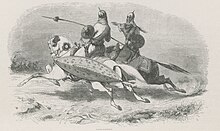Emirate of Nejd
Second Saudi State الدولة السعودية الثانية ( Arabic ) Emirate of Nejd إمارة نجد ( Arabic ) | |||||||||||||
|---|---|---|---|---|---|---|---|---|---|---|---|---|---|
| 1824–1891 | |||||||||||||
|
Abdul Rahman bin Faisal (last) | |||||||||||||
| History | |||||||||||||
• Reconquest of Riyadh | 1824 | ||||||||||||
• Battle of Mulayda with the Al Rashid | 24 January 1891 | ||||||||||||
| |||||||||||||
| Today part of | Saudi Arabia Qatar United Arab Emirates Oman | ||||||||||||
The Emirate of Nejd or Imamate of Nejd was the Second Saudi State, existing between 1824 and 1891 in
The second Saudi period was marked by less territorial expansion and less religious zeal, although the Saudi leaders continued to be called
History
The first Saudi to attempt to regain power after the fall of the Emirate of Diriyah in 1818 was Mishari bin Saud, a brother of the last ruler in Diriyah,
Turki was assassinated in 1834 by Mishari bin Abdul Rahman, a distant cousin. Mishari was soon besieged in Riyadh and later executed by Faisal, who went on to become the most prominent ruler of the Saudis' second reign. Faisal, however, faced a re-invasion of Najd organised by Mehmet Ali. The local population was unwilling to resist, and Faisal was defeated and taken to Egypt as a prisoner for the second time in 1838.

The Egyptians installed
Upon Faisal's death in 1865 the state began to decline due to the fact that different rulers, namely Abdullah, Saud, Abdul Rahman and Saud's sons, became the head of the state until 1891.[4] Immediately following the death of Faisal Abdullah assumed rule in Riyadh but was soon challenged by his brother, Saud. The two brothers fought a long civil war, in which they traded rule in Riyadh several times. A vassal of the Saudis, Muhammad bin Abdullah Al Rashid of Ha'il took the opportunity to intervene in the conflict and increase his own power. Gradually, Al Rashid extended his authority over most of Najd, including the Saudi capital, Riyadh. He finally expelled the last Saudi leader, Abdul Rahman bin Faisal, from Najd after the Battle of Mulayda in 1891.
Rulers
Abdul Rahman bin Faisal, last ruler of the Emirate.
- Imam Turki bin Abdullah bin Muhammad(first time) 1819–1820
- Imam Turki bin Abdullah bin Muhammad (second time) 1824–1834
- Imam Mishari bin Abdul Rahman bin Mishari 1834–1834 (Usurper)
- Imam Faisal bin Turki bin Abdullah Al Saud(first time) 1834–1838
- Imam Khalid bin Saud bin Abdulaziz Al Saud 1838–1841[5]
- Imam Abdullah bin Thunayan bin Ibrahim bin Thunayan bin Saud 1841–1843[5]
- Imam Faisal bin Turki bin Abdullah Al Saud (second time) 1843–1865
- Imam Abdullah bin Faisal bin Turki(first time) 1865–1871
- Imam Saud ibn Faisal1871–1871 (first time)
- Imam Abdullah bin Faisal bin Turki (second time) 1871–1873
- Imam Saud bin Faisal (second time) 1873–1875
- Imam Abdul Rahman bin Faisal(first time) 1875–1876
- Imam Abdullah bin Faisal bin Turki (third time) 1876–1889
- Imam Abdul Rahman bin Faisal (second time) 1889–1891
See also
- Unification of Saudi Arabia
- List of Sunni Muslim dynasties
References
- ^ Front Cover George Walter Prothero, Great Britain. Foreign Office. Historical Section. Peace Handbooks: Turkey in Asia (II), no. 61–66. H. M. Stationery Office, 1920. Pp. 20
- ISBN 9780521761284. Retrieved 18 February 2017.
- ^ Safran, Nadav. Saudi Arabia: The Ceaseless Quest for Security. Cornell University Press. 2018.
- ^ Mohamed Zayyan Aljazairi (1968). Diplomatic history of Saudi Arabia, 1903-1960's (PDF) (PhD thesis). University of Arizona. p. 13. Retrieved 26 November 2020.
- ^ a b Roby C. Barrett (June 2015). "Saudi Arabia: Modernity, Stability, and the Twenty-First Century Monarchy" (Report). Joint Special Operations University. p. 22. Archived (PDF) from the original on 8 May 2021. Retrieved 8 February 2021.
External links
- Second State of Saudi Arabia
- "The first and second Saudi states" Saudi Aramco World, January/February 1999, pp 4–11


